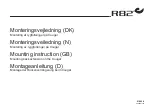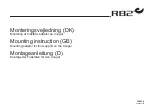
Rear Axle and Anti-tip Receiver Subassembly Adjustment
Note: The rear wheel location will be factory set to the standard position unless directed otherwise via
customer order. The Rear Wheel Axle location may be moved to any of four locations. To move the rear axle,
use the following procedure;
The Anti-tip Receiver is bolted to the Frame via the Axle Receiver and two 7/8 OD washers which prevent the
Anti-tip Subassembly from rotating. The 7/8 washers may be locked in to one of two possible locations,
depending on the desired location for the rear axle.
Decide which of four Rear Axle positions is desired. When using one of the two forward axle positions, the 7/8
OD washers should be in the Anti-tip Receiver ‘rearward’ hole. When using one of the two rearward axle
positions, the 7/8 OD washers should be in the ‘forward’ hole.
Assemble the 3/8-16 x 3/4” socket head screw, 3/8 ID x 7/8 OD washers (2 pcs), and 3/8 locking nut onto the
Anti-tip Receivers. Do not tighten the socket head screw and nut until the washers are seated into place into
an axle hole (see below).
For each Axle Receiver: Install the Axle Receiver plus the Anti-tip Receiver plus 2 washers (59/64 ID x 1-19/64
OD) plus one Receiver Nut. One of the washers should be installed between the receiver head and the 1 x 2
side tube. The other washer should be next to the nut. When the axle nut is nearly snug, use the hammer and
center punch to drive the 7/8 OD washers into one of the 7/8 ID holes in the side frame. Finish tightening all
screws and nuts. DO NOT OVER TIGHTEN AXLE NUT. SNUG IS ENOUGH!
Move Wheel Locks as required to match up with the new rear wheel location.
Upper Frame, Height and Tilt Adjustment
Note: The Frame height and seat tilt settings will be factory set to the standard position unless directed
otherwise via customer order. The seat height and tilt location may be moved to any of three heights and
tilts. To change seat height and tilt, use the following procedure;
To change seat height, loosen the set screw and then remove the 1/2” DIA bolt located under the frame
which connects the Upper Frame to the Lower Frame. When the 1/2” bolt is removed, you may vary the seat
height Be sure to maintain the original arrangement for shock absorbers. There should be a 1/2” long shock
absorber plus 2 washers positioned below the Lower Side Rail. There should be a 1” long shock absorber
located just below the Upper Frame, where the 1/2” bolt screws into the Upper Frame.
•
For a seat height of 15”, use the 5” bolt plus 1" urethane sleeve with no spacer.
•
For a seat height of 16”, use the 6” bolt plus 1" urethane sleeve and a 1” spacer.
•
For a seat height of 17”, use the 7” bolt plus 1" urethane sleeve and a 2” spacer.
Use only bolts and spacers provided by PDG. The 1/2” bolt must be threaded into the Upper Frame for a
length of at least 1”.
Re-tighten the set screw to ensure the 1/2” bolt will not become loose during wheelchair operation.
To change seat tilt, move the 3/8-16 bolt and nut, located in the rear part of the frame, to one of three
possible tilt locations as determined by the three holes in the rear of the Upper Frame Side Plate. DO NOT
OVER TIGHTEN NUTS. ‘BARELY SNUG’ IS ENOUGH. (Note that it is not possible to obtain posterior seat tilt at low
seat heights (14" or 15” seat height).
Wheel Lock Adjustment
Wheel locks are attached to the seat frame via two ¼ - 20 socket head bolts. There are locking nuts located
on the inside of the seat frame that can be easily accessed. To adjust the ‘snugness’ of wheel locks, slightly
loosen the socket head bolts, slide the wheel lock assembly forward or rearward as needed, then re-tighten
the socket head bolts. Test the adjustment by applying the wheel lock to ensure it can be adequately
engaged
Special Note: When seat height is set at high elevations and rear wheels are located in the most rearward
axle location, you may need to reverse-mount the wheel locks in order for the brake shoe to contact the
tire. This can be done by reverse mounting only the part of the wheel lock that mounts to the wheelchair
frame, therefore allowing the lever and shoe to be located more rearwardly.
11
































